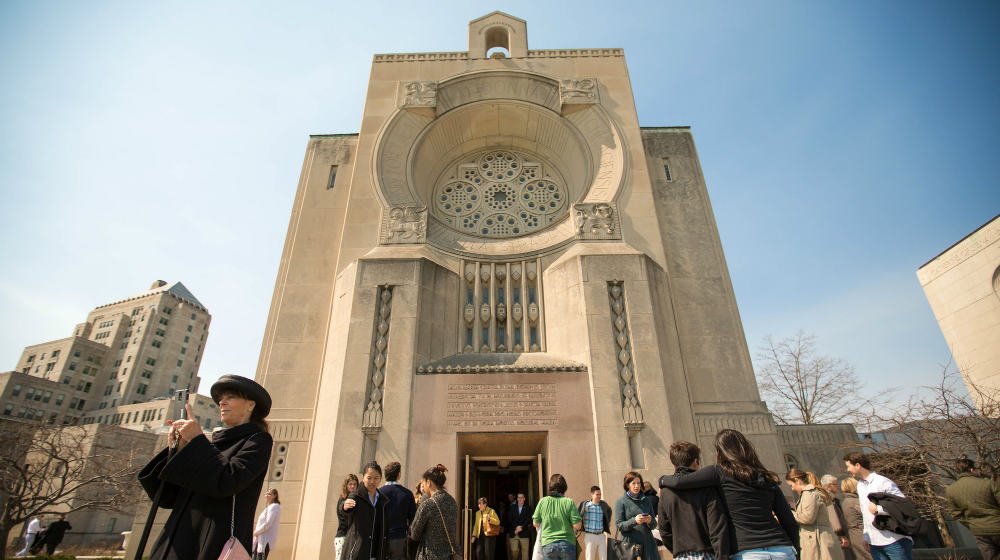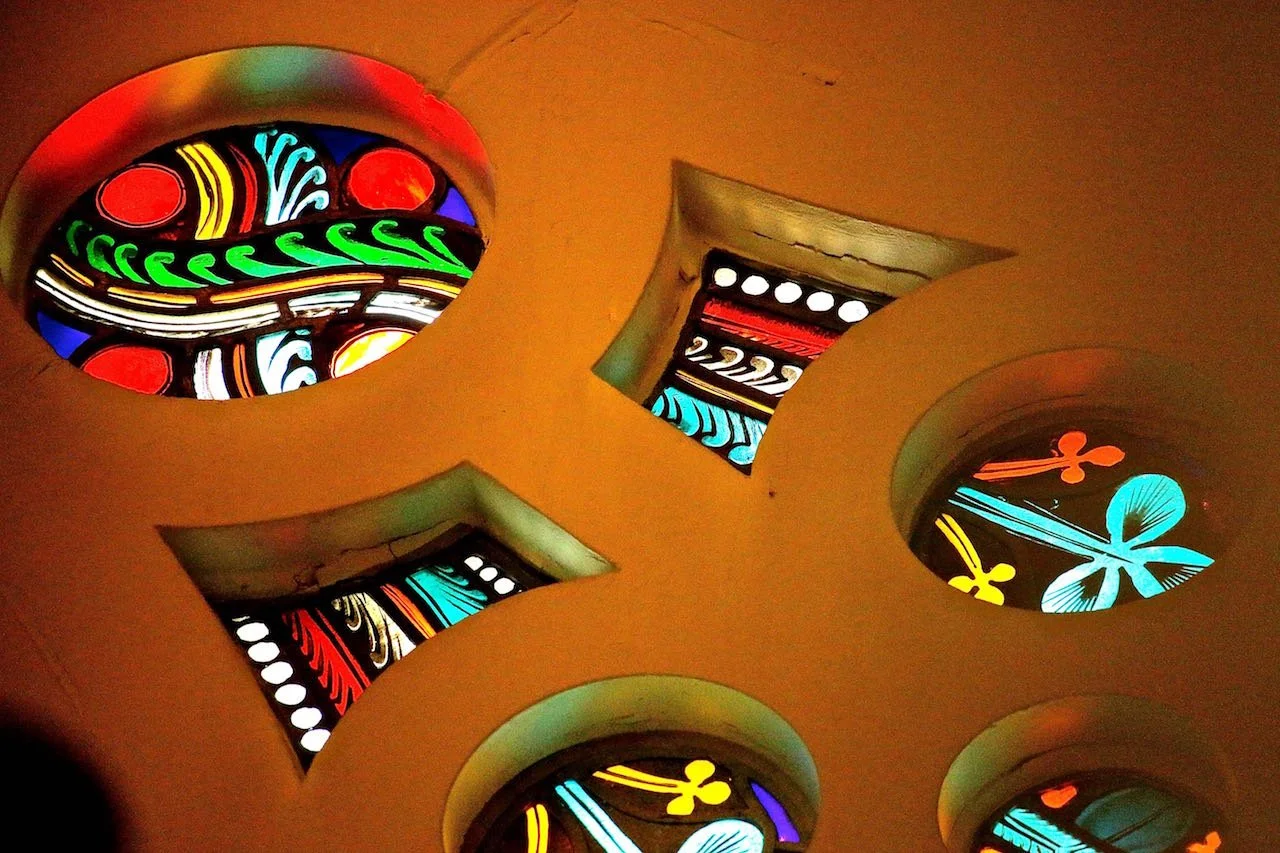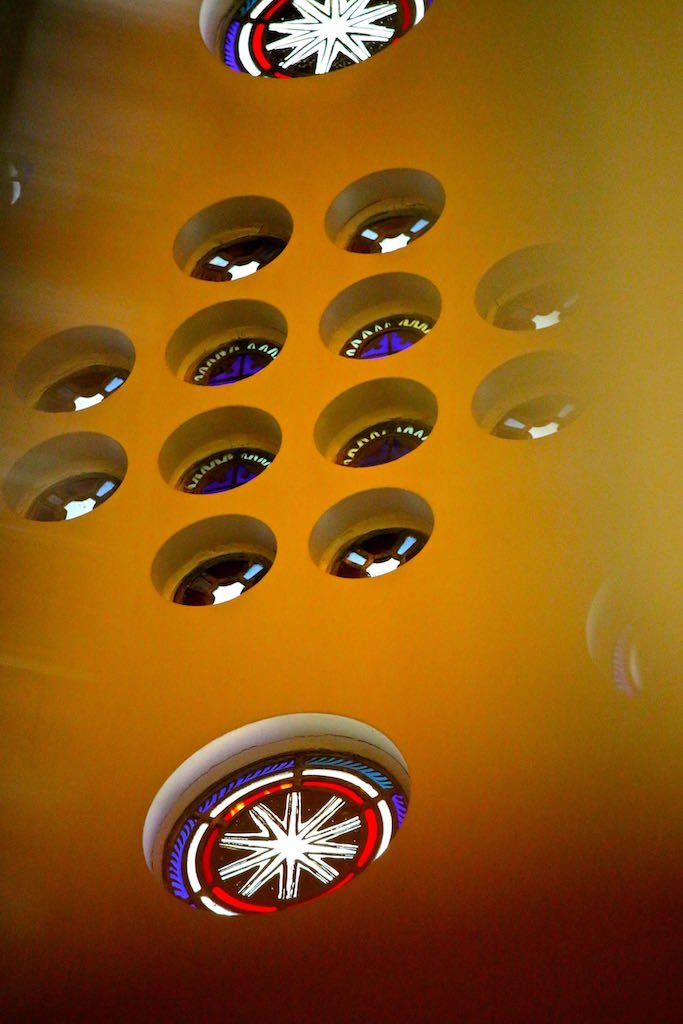Madonna della
Strada Chapel
Loyola University Campus, Chicago, Illinois
1938
Relief sculptures, mosaics, and stained glass window designs
The Madonna della Strada Chapel at the Lake Shore Campus of Loyola University stands as a gleaming art deco beacon in the Rogers Park neighborhood of Chicago. The modernist chapel was designed by architect Andrew Rebori and opened in 1943. Edgar Miller was a close friend and frequent collaborator with Rebori during the 1930s, and he submitted designs for many art installations for the chapel, including the large rose windows facing Lake Michigan at the front of the building. Its design process and many of its unique modernist-style ornamental pieces were created by a team of locally hired artists that included Miller, with many mysteries as to what elements were originally intended and which were ultimately incorporated.
Front facade of Madonna della Strada Chapel, with the central rose windows encircled by bas relief sculptures depicting effigies of the four gospel evangelists. (Photo: Loyola University)
The chapel was commissioned by senior priest of the Jesuit Order and university instructor Father James Mertz in 1924. The idea was to create a place of worship for the new North Side campus and so Father Mertz began a capital fundraising campaign to bring in $750,000 over the next fifteen years even during the economic downturn of the Great Depression. In 1929, Rebori was hired to design the edifice, and brought along a number of artists and designers, including Edgar Miller to assist with the project. Construction began in 1938. A partially finished chapel was opened to the public for services in 1943, with many design elements finished or reapplied over the next five years. It is believed that several elements by Edgar Miller never made it into the final design of the building.
The rose windows are a point of confusion because Miller and another craftsman-artist Karl Hackert both submitted designs for them, and while there is no evidence that Hackert's design was chosen, recent research done by a Loyola student, Guy Valponi, shows it was likely that Hackert was chosen as the final executor of the windows. Father Mertz, the priest in charge of the project, expressed that Hackert’s work was a lot cheaper and higher quality, although there are also reasons to believe that Mertz’s strong personality and Edgar’s devotion to art over practical costs created a rift between the two.
Also confusing to the observer is how closely in style and design the Hackert windows are to similar stained glass work by Edgar Miller. The rose window design also appears very similar to drawings in Miller’s sketchbooks for the project, and they exhibit his distinct design patterns, such as the use of clovers and a modern-medieval aesthetic. It is hard not to surmise that Hackert was hired to emulate Miller’s designs for a lower price. Regardless, the windows are spectacular and the influence of Edgar Miller’s style brings a joyful spirit and abundant color to the monumental windows.
Sketch of proposed rose windows by Miller. Photo by Alexander Vertikoff.
On the front facade of the building are four sculptural effigies in carved limestone reliefs depicting the Four Evangelists in mythical form (see Tetramorph). These sculptures aren't officially credited as Edgar Miller’s work, however the playful style points to Miller being their designer.
Vintage images of the bas relief sculptures of three of the Four Evangelists before they were attached to the front facade of the chapel.
It is unclear what pieces Edgar specifically created or designed inside the chapel, though much of the work inside is in his style. Miller submitted a proposal for the Stations of the Cross to be done as an elaborate mosaic, which would have wrapped completely around the chapel nave. The proposal was dismissed because of the limited budget, and another artist was chosen to paint the Stations. Valponi remarks that the evidence points to Hackert as the executor for the North American Martyrs Shrine.
Images of the crypt mosaics and the Madonna Shrine, likely to have been originally designed by Edgar Miller.
Ceiling and wall mosaics, stained glass windows, and cast bronze plaques in the Madonna Shrine show a resemblance to Miller's style and design sensibility.
Angel plaques (pictured above) bear a strong similarity to the Madonna and Child sculpture (pictured below), and are believed to be by Edgar Miller.
Madonna and Child credited to Miller, now in storage.
The Madonna della Strada Chapel remains one of the most unique and beautiful art deco churches in Chicago, and it still preserves and stewards exemplary works of Midwestern modernist design from the early 20th century. While there remain lingering mysteries surrounding the exact production schedule of the art, and why some pieces were selected for display and others were not, altogether the site remains one of Rebori and Miller’s most beautiful collaborations. The chapel still draws in large crowds today as a weekly service site for local worshippers and location of weddings and other religious ceremonies.



















